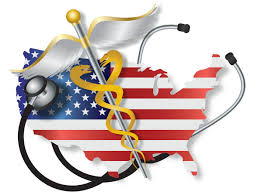
The United States is the 3rd most populous country with a population of over 331 million people. It has a mixed healthcare system that is comprised of public and private healthcare. It does not have universal healthcare. Healthcare is primarily made up of many distinct organizations, most of them private. The U.S.’s healthcare is ranked last in a study of 11 high-income countries. It has one of the lowest life expectancies and some of the highest mortality rates in the developed world. The United States spends the most of developed countries on healthcare with some of the worst outcomes. Around 92% of people have some form of coverage while about 8% have none. The healthcare system in the U.S. got started in the 1920s when employer-sponsored health insurance was introduced. After World War II the practice gained traction when the government started wage controls and declared fringe benefits, like health insurance, tax-exempt.
The first public insurance plans began in 1965 with the introduction of Medicare and Medicaid in the Social Security Act. Medicare ensures a universal right to health care for persons age 65 and older. Those covered and the benefits have gradually expanded. Medicaid gave states the option to receive federal funding for providing healthcare to low-income families, the blind and individuals with disabilities. Coverage was gradually made mandatory for low-income pregnant women and children. Currently it covers about 18% of Americans. In 1997, the Children’s Health Insurance Program was created as a state-administered program for children in low-income families that earn too much to qualify for Medicaid but can’t afford private insurance. In 2010, the Affordable Care Act was passed and implemented in 2014. It included: making healthcare mandatory or pay a fine, expanding Medicaid eligibility, opening health insurance marketplaces and allowing children to remain on their parents’ plans until 26. There’s also Veteran’s Health Administration and TRICARE available for members of the military.
Private insurance is the primary healthcare coverage for 67% of Americans. The majority of private insurance is employer-sponsored, about 55%. A smaller share of 11% is purchased by individuals from for-profit and nonprofit carriers. Most employers contract with private health plans for benefits. Most plans cover workers and their dependents. The majority of which offer a choice of several plans. Medicaid beneficiaries may receive their benefits through a private managed care organization, which receives capitated payments from state Medicaid departments. More than two-thirds of Medicaid beneficiaries are enrolled in managed care. For the public programs, there is no nationally defined benefits package. Services covered depend on insurance type. Private health coverage varies greatly depending on plans and insurance companies. Employer health coverage does not always include dental or vision.

Healthcare costs in the United States is very high and can be very expensive. The U.S. spends twice as much as most other highly developed nations like Canada, Australia and the U.K. It currently spends 16.9% of its GDP on healthcare. Public programs are financed through a variety of taxes. Private insurance is paid through premiums, some of which is covered by employers. Households finance about 28% of total healthcare costs, which is around the same amount as the government. Out-of-pocket costs account for about one-third of this. Patients typically pay the full cost up to a deductible. Some plans only require a copayment until it is met. Most out-of-pocket spending comes from dental, about 40%, and prescription costs, about 14%. There are very little caps on cost-sharing. About half of the country’s bankruptcies are due to medical expenses. 66.5% of bankruptcies happened due to a surprise medical bill in 2019.
The United States has world class medical care, if you can afford it. If you can’t, your health outcomes are worse than most other developed countries. The U.S. has one of the highest chronic disease burdens, as well as an obesity rate that is twice as high as other high-income countries. It has the highest infant and maternal mortality rates in the developed world. With Black Americans being much more likely to die than other minorities. America has the highest rate of hospitalizations from preventable causes and the highest rate of avoidable deaths. The U.S. the third-lowest rate of physician visits per capita of similar countries. Most likely due to the high cost of healthcare. It does outperform other developed countries in regards to preventative measures though. The ACA has helped those who previously didn’t have insurance afford it. More and more Americans are calling for further change to healthcare and hopefully more reforms come.
